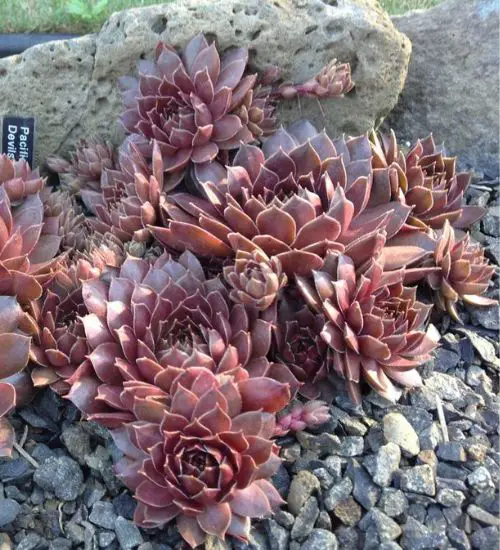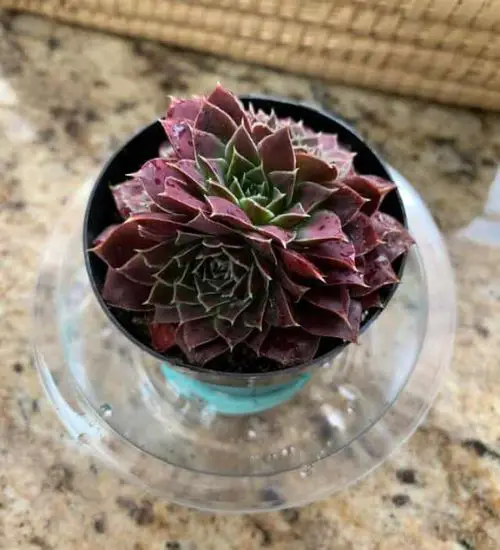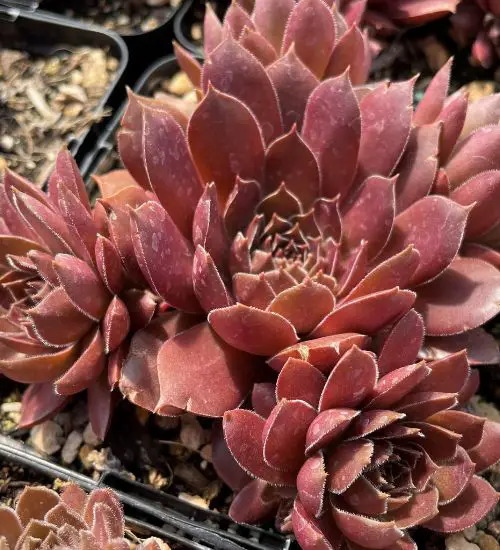Sun: full sun
Water: Typical water needs for a succulent
Temperature: Zone 4a from -4°30F to -25° F (-34.4 ° C to -31.7° C)
Winter Survival: Winter hardy
Propagation: offsets
Flower: in the late Summer or Fall
Flower Type:
Toxic: Generally non-toxic to humans and animals
Dormant: winter
Space Requirement: Outdoors
Common Problems: Plants may rot if overwatered, pests
Where to buy Sempervivum ‘Pacific Devil’s Food?
Basc Care for Sempervivum ‘Pacific Devil’s Food
Watering
Regular watering period should be every 2 weeks
You can water your succulent more than often in extreme conditions but make sure that the soil is completely dry before watering your succulent again.
Fertilizing
Only feed this succulent during its active growing seasons which means spring and fall. Use the right fertilizer applied in the right amounts. Applying half-strength balanced fertilizer every month or so is recommended for optimal results.
Do not fertilize during winter as the plant is dormant.
Sun & Location Requirements for "Hens and Chicks"
Sempervivum ‘Pacific Devil’s Food requires full sun for optimal growth and health. Place your succulent in a sunny spot in your garden or on a windowsill to ensure it's getting enough light. You'll know that the succulent is receiving enough sunlight if its leaves are bright green and firm.
As per this succulent profile, it is only able to stay healthy when the environment temperature is above the range of zone 4a from -4°30F to -25° F (-34.4 ° C to -31.7° C).
Sempervivum ‘Pacific Devil’s Food has excellent winter-hardy characteristics that allow it to survive in freeze conditions with ease. Its thick leaves and stems provide extra insulation against the cold weather, while its deep-rooted roots can absorb moisture from the air even when temperatures drop below freezing. Furthermore, its ability to store water helps it survive long stretches of cold weather without any problems.
Any succulents in the group will need a large space to grow. You should place your pot outdoor. Since this plant needs a lot of space than other succulents, you should consider not planting them together with other succulents/plants.
Propagation
Offsets are an easy and reliable way to propagate succulents, like Sempervivum ‘Pacific Devil’s Food. With just a few simple steps, you can get a brand-new plant from an existing one.
Toxicity

Sempervivum ‘Pacific Devil’s Food is not known to pose any significant health risks, as it is not considered to be toxic. However, it is best to keep the plant away from young children and pets, as they may ingest some of the parts of this plant that could contain toxins which can cause mild skin irritation.
Pests and Diseases
Sempervivum ‘Pacific Devil’s Food can be affected common pests and diseases like most of the other succulents such as aphids, mealybugs, and scale insects.
If you do spot any of pest signs, you can treat your succulent using below methods.
- Aphids: quarantine, clean infected plants, soapy water.
- Mealybugs: quarantine, clean infected plants, soapy water.
- Scale insects: quarantine, clean infected plants, soapy water.
Besides that, to prevent serious health issues from happening, keep your succulent in a well-ventilated area and check it regularly for any signs of pests or health problems.


